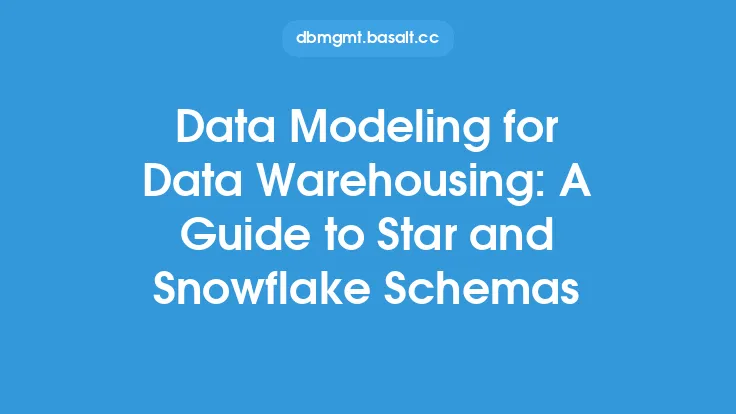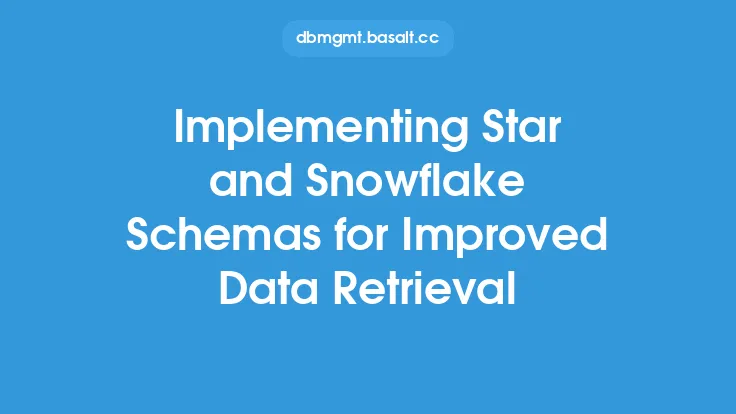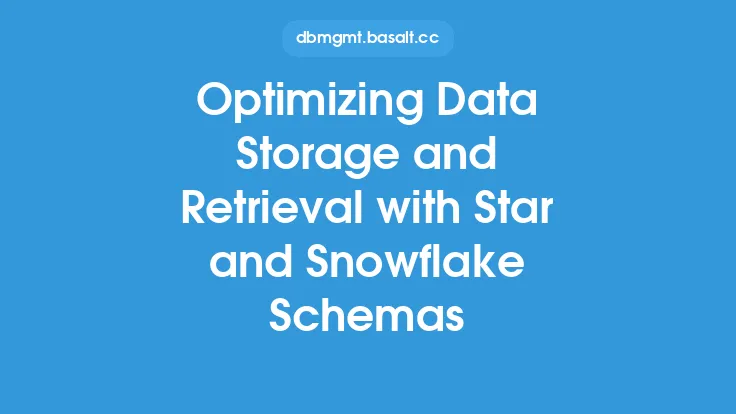In the realm of data denormalization, two prominent schema designs have emerged as cornerstones for optimizing data storage and retrieval: Star and Snowflake Schemas. These schemas are specifically tailored for data warehousing environments, where the primary focus is on querying and analyzing large datasets. Understanding the fundamentals of these schemas is crucial for designing efficient data warehouses that can handle complex queries and provide fast data retrieval.
Introduction to Star Schemas
A Star Schema is a database design pattern that consists of a central fact table surrounded by dimension tables. The fact table contains measurable data, such as sales amounts or website traffic, while the dimension tables provide context to the fact data, like date, location, or product information. Each dimension table is connected to the fact table using a single join, forming a "star" shape. This design allows for efficient querying and aggregation of data, as the fact table can be easily joined with multiple dimension tables to create a unified view of the data.
Introduction to Snowflake Schemas
A Snowflake Schema is an extension of the Star Schema, where each dimension table is further normalized into multiple related tables. This creates a more complex, "snowflake" shape, with each dimension table connected to the fact table through a series of joins. Snowflake Schemas are useful when there are multiple levels of granularity in the dimension data, such as a date dimension that includes year, quarter, month, and day tables. By normalizing the dimension tables, Snowflake Schemas can reduce data redundancy and improve data integrity, but they can also increase query complexity and slow down data retrieval.
Key Components of Star and Snowflake Schemas
Both Star and Snowflake Schemas rely on several key components to function effectively:
- Fact Tables: These tables contain the measurable data, such as sales amounts or website traffic. Fact tables are typically large and contain a high volume of data.
- Dimension Tables: These tables provide context to the fact data, such as date, location, or product information. Dimension tables are typically smaller than fact tables and contain a lower volume of data.
- Keys: Each table in a Star or Snowflake Schema has a unique key, which is used to join the tables together. In a Star Schema, the fact table has a foreign key that references the primary key of each dimension table. In a Snowflake Schema, each dimension table has a foreign key that references the primary key of the next level of granularity.
- Joins: Joins are used to combine data from multiple tables into a single result set. In a Star Schema, the fact table is joined to each dimension table using a single join. In a Snowflake Schema, each dimension table is joined to the next level of granularity using a series of joins.
Benefits of Star and Snowflake Schemas
Both Star and Snowflake Schemas offer several benefits, including:
- Improved Query Performance: By denormalizing data and reducing the number of joins required, Star and Snowflake Schemas can improve query performance and reduce the time it takes to retrieve data.
- Simplified Data Analysis: Star and Snowflake Schemas provide a simplified view of complex data, making it easier to analyze and understand.
- Increased Data Integrity: By reducing data redundancy and improving data consistency, Star and Snowflake Schemas can increase data integrity and reduce errors.
Challenges and Considerations
While Star and Snowflake Schemas offer several benefits, there are also several challenges and considerations to keep in mind:
- Data Complexity: Star and Snowflake Schemas can be complex and difficult to design, especially for large datasets.
- Data Volume: Star and Snowflake Schemas can handle large volumes of data, but they can also become slow and unwieldy if not properly optimized.
- Query Complexity: Snowflake Schemas, in particular, can increase query complexity and slow down data retrieval if not properly designed.
Best Practices for Implementing Star and Snowflake Schemas
To get the most out of Star and Snowflake Schemas, follow these best practices:
- Keep it Simple: Avoid overly complex designs, and focus on simplicity and ease of use.
- Optimize for Query Performance: Design your schema with query performance in mind, and optimize for the most common queries.
- Use Appropriate Data Types: Use appropriate data types for each column, and avoid using unnecessary data types that can slow down query performance.
- Monitor and Maintain: Regularly monitor and maintain your schema, and make adjustments as needed to ensure optimal performance.
Conclusion
Star and Snowflake Schemas are powerful tools for optimizing data storage and retrieval in data warehousing environments. By understanding the fundamentals of these schemas and following best practices for implementation, you can create efficient and effective data warehouses that provide fast and accurate data retrieval. Whether you choose a Star or Snowflake Schema, the key is to design a schema that meets the needs of your organization and provides a solid foundation for data analysis and decision-making.





